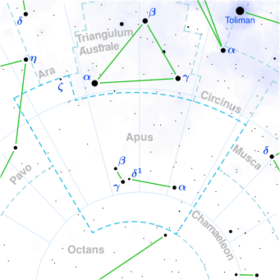Astronomy:HD 124099
| Observation data Epoch J2000.0 Equinox (celestial coordinates) | |
|---|---|
| Constellation | Apus |
| Right ascension | 14h 16m 55.14838s[1] |
| Declination | −77° 39′ 51.1971″[1] |
| Apparent magnitude (V) | 6.47[2] (6.46 - 6.49)[3] |
| Characteristics | |
| Spectral type | K2 IIp[4] |
| U−B color index | +1.33[5] |
| B−V color index | +1.42[6] |
| Variable type | SRD:[3] |
| Astrometry | |
| Radial velocity (Rv) | −10.2±0.4[7] km/s |
| Proper motion (μ) | RA: −4.602[1] mas/yr Dec.: −3.712[1] mas/yr |
| Parallax (π) | 1.6098 ± 0.0195[1] mas |
| Distance | 2,030 ± 20 ly (621 ± 8 pc) |
| Absolute magnitude (MV) | −2.10[8] |
| Details | |
| Mass | 4.22[9] M☉ |
| Radius | 71.4+3.2−13.5[10] or 99.4±2.4[1] R☉ |
| Luminosity | 1,545±46[10] or 2,926+74−75[1] L☉ |
| Surface gravity (log g) | 1.29[9] cgs |
| Temperature | 4,426±122[11] K |
| Metallicity [Fe/H] | −0.21[12] dex |
| Rotational velocity (v sin i) | 5.6±2.0[13] km/s |
| Other designations | |
| Database references | |
| SIMBAD | data |
HD 124099 (HR 5306; NSV 20066; 7 G. Apodis) is a solitary orange-hued star located in the southern circumpolar constellation Apus. It has an average apparent magnitude of 6.47,[2] placing it very close to the limit for naked eye visibility, even under ideal conditions. The object is located relatively far at a distance of approximately 2,030 light-years based on Gaia DR3 parallax measurements,[1] but it is drifting closer with a heliocentric radial velocity of −10.2 km/s.[7] At its current distance, HD 124099's average brightness is diminished by 0.47 magnitudes due to interstellar extinction[15] and it has an absolute magnitude of −2.10.[8]
HD 124099 has a stellar classification of K2 IIp,[4] indicating that it is an evolved K-type bright giant with peculiarities in its spectrum; the peculiarity being that it has either a very weak or no G-band in its spectrum. It has 4.22 times the mass of the Sun[9] but it has expanded to 71.4 times the radius of the Sun.[10] It radiates 1,545 times the luminosity of the Sun from its enlarged photosphere at an effective temperature of 4,426 K.[11] However, Gaia DR3 stellar evolution models give a larger radius of 99.4 R☉ and a higher luminosity of 2,926 L☉.[1] HD 124099 is metal deficient with an iron abundance 61.2% that of the Sun's ([Fe/H] = −0.21)[12] and it spins modestly with a projected rotational velocity of 5.6 km/s.[13] The star is suspected to be a semiregular variable of the SRD subtype and it ranges from 6.46 to 6.49 within 528 days.[3]
References
- ↑ 1.0 1.1 1.2 1.3 1.4 1.5 1.6 1.7 Vallenari, A. et al. (2022). "Gaia Data Release 3. Summary of the content and survey properties". Astronomy & Astrophysics. doi:10.1051/0004-6361/202243940 Gaia DR3 record for this source at VizieR.
- ↑ 2.0 2.1 Høg, E.; Fabricius, C.; Makarov, V. V.; Urban, S.; Corbin, T.; Wycoff, G.; Bastian, U.; Schwekendiek, P. et al. (March 2000). "The Tycho-2 catalogue of the 2.5 million brightest stars". Astronomy and Astrophysics 355: L27–L30. ISSN 0004-6361. Bibcode: 2000A&A...355L..27H.
- ↑ 3.0 3.1 3.2 3.3 "VSX : Detail for NSV 20066". https://www.aavso.org/vsx/index.php?view=detail.top&oid=58501.
- ↑ 4.0 4.1 Houk, N.; Cowley, A. P. (1975). University of Michigan Catalogue of two-dimensional spectral types for the HD stars: Declinations −90° to −53°. 1. Bibcode: 1975mcts.book.....H.
- ↑ Stagg, Christopher (1983). "The southern Be star photometric campaign - A first report". Hvar Observatory Bulletin 7 (1): 143–146. ISSN 0351-2657. Bibcode: 1983HvaOB...7..143S.
- ↑ Cousins, A. W. J.; Stoy, R. H. (1962). "Photoelectric magnitudes and colours of Southern stars.". Royal Greenwich Observatory Bulletins 64: 103. Bibcode: 1962RGOB...64..103C.
- ↑ 7.0 7.1 Gontcharov, G. A. (November 2006). "Pulkovo Compilation of Radial Velocities for 35,495 Hipparcos stars in a common system". Astronomy Letters 32 (11): 759–771. doi:10.1134/S1063773706110065. ISSN 1063-7737. Bibcode: 2006AstL...32..759G.
- ↑ 8.0 8.1 Corbally, C. J.; Garrison, R. F. (1984). "Which Map of Absolute Magnitudes: Keenan or Schmidt-Kaler?". The Mk Process and Stellar Classification: 277. Bibcode: 1984mpsc.conf..277C.
- ↑ 9.0 9.1 9.2 Anders, F. et al. (February 2022). "Photo-astrometric distances, extinctions, and astrophysical parameters for Gaia EDR3 stars brighter than G = 18.5". Astronomy & Astrophysics 658: A91. doi:10.1051/0004-6361/202142369. ISSN 0004-6361. Bibcode: 2022A&A...658A..91A.
- ↑ 10.0 10.1 10.2 Brown, A. G. A. (August 2018). "Gaia Data Release 2: Summary of the contents and survey properties". Astronomy & Astrophysics 616: A1. doi:10.1051/0004-6361/201833051. Bibcode: 2018A&A...616A...1G. Gaia DR2 record for this source at VizieR.
- ↑ 11.0 11.1 Stassun, Keivan G. et al. (9 September 2019). "The Revised TESS Input Catalog and Candidate Target List". The Astronomical Journal 158 (4): 138. doi:10.3847/1538-3881/ab3467. Bibcode: 2019AJ....158..138S.
- ↑ 12.0 12.1 Poggio, E.; Recio-Blanco, A.; Palicio, P. A.; Re Fiorentin, P.; de Laverny, P.; Drimmel, R.; Kordopatis, G.; Lattanzi, M. G. et al. (30 September 2022). "The chemical signature of the Galactic spiral arms revealed by Gaia DR3". Astronomy & Astrophysics 666: L4. doi:10.1051/0004-6361/202244361. ISSN 0004-6361. Bibcode: 2022A&A...666L...4P.
- ↑ 13.0 13.1 De Medeiros, J. R.; Alves, S.; Udry, S.; Andersen, J.; Nordström, B.; Mayor, M. (January 2014). "A catalog of rotational and radial velocities for evolved stars V: Southern stars *". Astronomy & Astrophysics 561: A126. doi:10.1051/0004-6361/201220762. ISSN 0004-6361. Bibcode: 2014A&A...561A.126D.
- ↑ SIMBAD, HD 124099 (accessed 20 September 2015)
- ↑ Guarinos, J. (February 1995). "VizieR Online Data Catalog: Interstellar matter in the Galactic Disk (Guarinos J., 1992)". VizieR Online Data Catalog: 301V/86. Bibcode: 1995yCat.5086....0G.
<ref> tag with name "Gould1879" defined in <references> is not used in prior text.
 |


